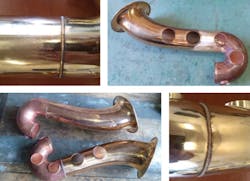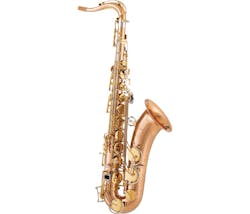Process creates reliable joints in brass instrument production
TOMÁŠ MUŽÍK and VLADIMÍR HAVRÁNEK
Amati-Denak produces all kinds of woodwind and brasswind instruments, from medium- to luxury-quality level. While the company has a rich history dating back to the 17th century, progress has not stopped. Recently, they made a dramatic technology change in the production of trumpets and saxophones (FIGURE 1). What were manually soldered joints on brass parts has been replaced by laser welding, specifically for their top-class instruments.
FIGURE 1. An example of a saxophone produced at Amati-Denak.
Amati-Denak, with 200 employees, ranks as the leader in the market regarding assortment range and quality. As a result, it is one of the largest manufacturers of musical instruments in Europe. All of the company’s products are made in its main factory in Kraslice, Czech Republic, where there is a rich tradition in making woodwind and brasswind musical instruments. A second factory is situated in Hradec Králové, where all rotary valve instruments of VF Červený are manufactured. In 2016, the British Geneva company acquired a majority of Amati-Denak, which started another chapter in the company history. There are now more premium brands being added to the Amati-Denak and VF Červený portfolio—Geneva, Oldroyd Cardinal, and Lineage.
Company history
Despite the current economic situation in central Europe, the company managed to ensure sufficient production and sales mainly because of modern handicraft production, which builds on years of experience and passion for making musical instruments.
Amati-Denak is currently collaborating with musicians dedicated to producing high-quality musical wind instruments with a unique full sound, which is in demand in the current music world. The combination of modern handicraft, together with the understanding of musicians and their requirements, provides the company with a basis for making wind instruments of the highest quality on the market.
The company can satisfy the tastes and requirements of all musicians. Primarily, however, they aim to satisfy advanced players and professionals. This diversity of product range with unique variations gives customers the ability to choose the instrument consistent with the personality and style of each individual musician. The main goal of the company is to supply customers with high-quality instruments that bring not only the perfect sound, but also the joy of music.
Amati-Denak’s musical instruments are manufactured in the cities of Kraslice and Hradec Králové. Musical instrument-making had become a tradition in both cities hundreds of years ago, and each city underwent a completely different historical evolution. Kraslice can be considered a cradle of musical instrument production in the country, as stringed instruments were first produced there at the beginning of the 17th century.
Melchior Lorenz was the first legally confirmed musical instrument maker. In the 18th century, the instrument makers of Kraslice adapted to the boom of orchestral music and aside from violin-making, they engaged in the production of wind instruments.
Technical improvements of wind instruments at the beginning of the 19th century, in which the Kraslice musical instrument makers participated, made it easier to play, enabling better virtuosity of the players. That, in turn, resulted in increased interest in playing these instruments.
Instrument makers wanted to meet and satisfy most players’ demands, thus making Austrian and French system instruments in Kraslice and, from the beginning of the 19th century, musical toys as well. The first factory had been established in Kraslice in 1840 and shortly afterwards, others followed. By the end of the 19th century, there were already 11 factories in operation, employing around 300 workers. About 500 additional people were involved in domestic production. In the city, there were 16 merchants trading musical instruments.
Production quickly recovered after World War I. Between the two World Wars, there were 59 musical instrument manufacturers—among the biggest of these firms were Bohland & Fuchs, Hüller & Co., A. K. Hüttl, Julius Keilwerth, Karl Püchner, Adolf Rölz, and Ant.Kohlert. However, during WWII, many plants ceased to exist, while others served military purposes.
In September 1945, a cooperative of musical instrument manufacturers was established in Kraslice. And because the production of both wind and stringed instruments was anticipated, the cooperative was given the name Amati.
In 1948, the entire production was nationalized. Kraslice gradually became a center of wind and percussion instrument manufacture. At present, the assortment of wind instruments produced in Kraslice is unusually wide and made up of practically all common instruments. In Kraslice, cases are also produced for instruments, cymbals, and the whole range of Orff musical instruments that are simple and easy to play, even for first-time musicians. Students of the Orff Approach, learning by doing, play instruments alone as well as in groups.
All instruments are manufactured from quality materials, with a high level of handcraftsmanship combined with modern technology. Amati-Denak instruments are sought after for their award-winning features, such as beautiful and mellow sound quality, good intonation, functional reliability, perfect workmanship, and very reasonable prices.
Laser technology for brass welding
Although Amati-Denak is a very traditional company, it has always been looking for innovations and best-available technologies to bring design and sound of their instruments to the absolute top level. They identified one technological issue in joining technology in the production of trumpets and saxophones. For several reasons, they must be produced as an assembly welded from several parts, sometimes made from different brass grades. These joints have been done by means of soldering using lead-based solder or by plasma-transferred arc (PTA) welding. This is a proven and easy technology—however, there is always a small notch remaining on the inner surface of the instrument, causing small sound disturbance. PTA welding has other technological challenges, too, including changing the joining technology to avoid grooves.
After conventional-technology welding trials failed to create reliable joints, Amati-Denak asked the company MATEX PM for assistance. Welding technologists at MATEX, working with technical people from Amati-Denak, managed to prepare a reliable clamping device and after several trials, they found proper parameters for reliable laser welding process and presented laser-welded samples (FIGURE 2).
FIGURE 2. Examples of laser-welded sample pieces for saxophones are shown.
MATEX used one of their robotic laser cells to produce welded joints for Amati-Denak. It is based on a KUKA robot and Laserline’s fiber-guided diode laser, with available 5 kW laser power as well as continuous-wave and pulsed modes. Also tested were many protecting gas mixtures. In brass instrument construction, several brass grades and slightly different sheet thicknesses may be used. This caused concern because of the very high reflectivity of laser light from copper alloys. However, this effect turned out to be manageable. The most demanding challenge was construction of a precise clamping device, which can keep complex-shaped instruments in precise position during the welding process.
Amati-Denak’s processing needs were readily accomplished with laser welding, as several brass grades can be used, the metal surface can be in the shiny polished condition, and no additive material is needed. Only the best quality joints are allowed, with no wavy surface, no porosity, and no post-weld steps on both surfaces. There is no other surface treatment done before welding and no preheating is allowed. Weld seams are done as butt joints, without filler wire, and the joints are only mechanically polished after welding to make them virtually invisible. Welding speed and price-per-meter of weld seam are taken as unimportant parameters because it is obviously very fast and affordable compared to other production steps. Most important is visual quality of the instrument. The success in welding lies not in laser wavelength—the diode laser is similar to neodymium-doped yttrium aluminum garnet (Nd:YAG), but combines proper pulse length related to metal sheet thickness, welding speed, and appropriate shielding gas.
MATEX used to concentrate on laser hardening for the automotive and heavy machinery industries, so its laser operators and welding engineers were quite surprised and skeptical about this job. Later, it was taken as a new opportunity and a chance to prove their mastery. It was necessary to make many trials, lab analyses, and changes in clamping, and it took quite a long time to set the proper parameters. However, after the first parts were successfully welded, their pride and satisfaction with the breakthrough were clearly visible. It wouldn’t have been possible to solve the technology issues without their enthusiasm and skills.
Today, laser welding is used for production of some types of top-class instruments. It is something different than mass production for automotive, which is a typical application for laser welding. This application is more like prototype production, but Amati-Denak and MATEX are sure that laser technology helps to create masterpieces with very unique design and sound. Laser robotic welding instead of conventional soldering and welding is now the main process for making brass instruments, as it meets Amati-Denak’s goal of getting a perfect connection of parts made from brass material.
TOMÁŠ MUŽÍK ([email protected]) is with MATEX PM, Plzeň, Czech Republic; www.matexpm.com/en, while VLADIMÍR HAVRÁNEKis with Amati-Denak, Kraslice, Czech Republic; www.amati.cz/en.

